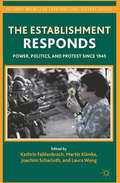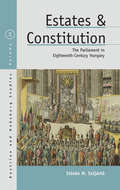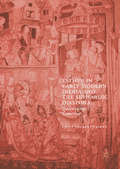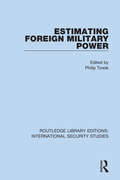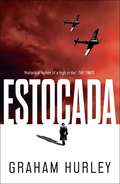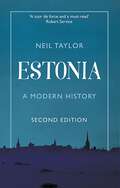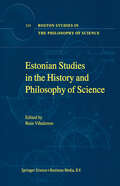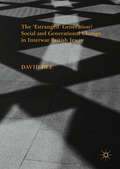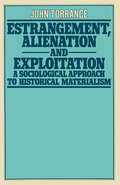- Table View
- List View
Establishing Quantum Physics in Munich: Emergence of Arnold Sommerfeld’s Quantum School (SpringerBriefs in History of Science and Technology)
by Michael EckertThis book traces the history of Arnold Sommerfeld’s famous “nursery of theoretical physics” at the University of Munich and demonstrates the centrality of developing personal and institutional networks for the emergence of quantum theory. Sommerfeld, originally a mathematician with little interest in theoretical physics, was a somewhat unlikely choice for a chair of theoretical physics when he was appointed in 1906. However, he quickly reoriented his research focus towards physics, forstering a keen interest in experimental research. Possibly even more important for the development of quantum theory in the coming years was his exceptional talent as a charismatic teacher and prolific networker, which turned Munich into a central node in the fast-growing network of quantum physicists in the 1920s. It is no coincidence that the two most talented “child prodigies” of 1920s quantum physics, Wolfgang Pauli and Werner Heisenberg, were his students, nor that by the end of the decade about a dozen of Sommerfeld’s former disciples held chairs in theoretical physics. The book is directed at historians of science and physics, as well as all those interested in the history of science diplomacy and networking.
The Establishment and Reconstruction of the Academician System in China
by Jinhai GuoThis book is the first monograph to study the processes of establishing and reconstructing the academician system, and the landmark events in the history of science and technology in 20th century China. It also provides new insights to help us understand the process of scientific institutionalization in modern China. Drawing on detailed archive records, it discusses the process of the establishment of the Academia Sinica's academician system in the Republic of China, as well as the unique and tortuous transformation process from members of the Academic Divisions(学部委员)to academicians of the Chinese Academy of Sciences(中国科学院)in the People's Republic of China. These play an important part of China's modernization process, and reflect scientific institutionalization in China. The book also highlights the fact that under the leadership of the government, the academic elite became participants in the construction of national academic system after the founding of the People's Republic of China.
Establishment Eschatology in England’s Reformation: Evidence from the Doctrinally-Binding Formularies of Faith, 1534–1571
by Tim PatrickExploring what the early English Protestants came to believe about the afterlife, and how they arrived at their positions, this much-needed book fills a gap in the scholarly literature. In surveying the authorised doctrinal works of the English church through the Reformation period, the progress of eschatological thinking is traced from the earliest days of change to the solidification of the formularies which remain binding across the worldwide Anglican Church today. Fresh observations are made on some well-known texts such as the Books of Common Prayer, Articles of Religion and official Tudor homilies, and these are complemented by commentary on surprisingly understudied documents of the period including primers, catechisms, and the paratexts of the early printed English Bibles. The result is a fascinating study of the English reformers’ navigation past both Roman Catholic and radical anabaptist beliefs, and it shows that their arrival at a relatively barren destination was due in part to a complete switch in theological priorities and in part to a fear of the implications of formally adopting some of the highly contested views. Establishment Eschatology will prove to be an important resource for students and scholars of England’s early modern religious and cultural history.
Establishment Eschatology in England’s Reformation: Evidence from the Doctrinally-Binding Formularies of Faith, 1534–1571
by Tim PatrickExploring what the early English Protestants came to believe about the afterlife, and how they arrived at their positions, this much-needed book fills a gap in the scholarly literature. In surveying the authorised doctrinal works of the English church through the Reformation period, the progress of eschatological thinking is traced from the earliest days of change to the solidification of the formularies which remain binding across the worldwide Anglican Church today. Fresh observations are made on some well-known texts such as the Books of Common Prayer, Articles of Religion and official Tudor homilies, and these are complemented by commentary on surprisingly understudied documents of the period including primers, catechisms, and the paratexts of the early printed English Bibles. The result is a fascinating study of the English reformers’ navigation past both Roman Catholic and radical anabaptist beliefs, and it shows that their arrival at a relatively barren destination was due in part to a complete switch in theological priorities and in part to a fear of the implications of formally adopting some of the highly contested views. Establishment Eschatology will prove to be an important resource for students and scholars of England’s early modern religious and cultural history.
The Establishment of National Republics in Soviet Central Asia
by A. HaugenAfter almost four centuries of expansion the Russian Empire at the beginning of the 20th century covered vast territories on the Eurasian continent and included an immensely diverse population. How was the new Russian regime to deal with the complexity of its population? This book examines the role of nation and nationality in the Soviet Union and analyzes the establishment of national republics in Soviet Central Asia. It argues that the originally nationally minded Soviet communists with their anti-nationalist attitudes came to view nation and national identity as valuable tools in state building.
The Establishment of Spanish Rule in America
by Bernard MosesFirst Published in 1966. The Establishment of Spanish Rule in America, AN INTRODUCTION TO THE HISTORY AND POLITICS OF SPANISH AMERICA has been written to present the main events connected with the establishment of Spanish rule in America, and to describe briefly the more important features of Spain’s colonial organization and policy. It aims, by the use of certain historical facts, to make clear to ordinary readers and to students in high schools and colleges the origin and character of the political and economic institutions constructed for the government of Spanish America
The Establishment of Spanish Rule in America
by Bernard MosesFirst Published in 1966. The Establishment of Spanish Rule in America, AN INTRODUCTION TO THE HISTORY AND POLITICS OF SPANISH AMERICA has been written to present the main events connected with the establishment of Spanish rule in America, and to describe briefly the more important features of Spain’s colonial organization and policy. It aims, by the use of certain historical facts, to make clear to ordinary readers and to students in high schools and colleges the origin and character of the political and economic institutions constructed for the government of Spanish America
The Establishment Responds: Power, Politics, and Protest since 1945 (Palgrave Macmillan Transnational History Series)
by Kathrin Fahlenbrach, Martin Klimke, Joachim Scharloth & Laura WongThis volume fills this gap by examining the many ways in which political parties, the business world, foreign policymakers, and the intelligence community experienced, confronted, and even actively contributed to domestic and transnational forms of dissent.
Estate Management around Florence and Lucca 1000-1250 (Oxford Historical Monographs)
by Dr Lorenzo TabarriniThis book examines the forms of estate management in the countryside of Florence and Lucca between the eleventh and the middle of the thirteenth centuries. It argues that their change reflects wider transformations of medieval economic patterns, and specifically the surge in overall demand that occurred in the decades bridging the twelfth and the thirteenth centuries. The reasons for a comparison between the Florentine and the Lucchese countryside lie in the alleged differences of their historical evolution—as it has been outlined by scholars so far. The so-called manorial system (sistema curtense) is believed to have ceased to exist in the Lucchesia around the beginning of the tenth century, whereas in the Fiorentino its disappearance can be dated to the early thirteenth century. Similarly, the Florentine countryside is generally regarded as the birthplace of a particular type of sharecropping regime, the mezzadria poderale, which spread over much of central Italy during the fifteenth and sixteenth centuries and would later become an essential component of Italian agrarian identity. On the contrary, the mezzadria poderale is thought to have never developed at any point in the history of medieval and early modern Lucchesia—and this was indeed the case with all the coastal areas of Tuscany. The book endeavours to examine the characteristics of estate management in the central Middle Ages in their own right; that is to say, by detaching those transformations from any teleological view, and by placing them within the economic and sociopolitical context of the period 1000-1250.
Estate Management around Florence and Lucca 1000-1250 (Oxford Historical Monographs)
by Dr Lorenzo TabarriniThis book examines the forms of estate management in the countryside of Florence and Lucca between the eleventh and the middle of the thirteenth centuries. It argues that their change reflects wider transformations of medieval economic patterns, and specifically the surge in overall demand that occurred in the decades bridging the twelfth and the thirteenth centuries. The reasons for a comparison between the Florentine and the Lucchese countryside lie in the alleged differences of their historical evolution—as it has been outlined by scholars so far. The so-called manorial system (sistema curtense) is believed to have ceased to exist in the Lucchesia around the beginning of the tenth century, whereas in the Fiorentino its disappearance can be dated to the early thirteenth century. Similarly, the Florentine countryside is generally regarded as the birthplace of a particular type of sharecropping regime, the mezzadria poderale, which spread over much of central Italy during the fifteenth and sixteenth centuries and would later become an essential component of Italian agrarian identity. On the contrary, the mezzadria poderale is thought to have never developed at any point in the history of medieval and early modern Lucchesia—and this was indeed the case with all the coastal areas of Tuscany. The book endeavours to examine the characteristics of estate management in the central Middle Ages in their own right; that is to say, by detaching those transformations from any teleological view, and by placing them within the economic and sociopolitical context of the period 1000-1250.
Estates and Constitution: The Parliament in Eighteenth-Century Hungary (Austrian and Habsburg Studies #30)
by István M. SzijártóAcross eighteenth-century Europe, political power resided overwhelmingly with absolute monarchs, with notable exceptions including the much-studied British Parliament as well as the frequently overlooked Hungarian Diet, which placed serious constraints on royal power and broadened opportunities for political participation. Estates and Constitution provides a rich account of Hungarian politics during this period, restoring the Diet to its rightful place as one of the era’s major innovations in government. István M. Szijártó traces the religious, economic, and partisan forces that shaped the Diet, putting its historical significance in international perspective.
Estates and Constitution: The Parliament in Eighteenth-Century Hungary (Austrian and Habsburg Studies #30)
by István M. SzijártóAcross eighteenth-century Europe, political power resided overwhelmingly with absolute monarchs, with notable exceptions including the much-studied British Parliament as well as the frequently overlooked Hungarian Diet, which placed serious constraints on royal power and broadened opportunities for political participation. Estates and Constitution provides a rich account of Hungarian politics during this period, restoring the Diet to its rightful place as one of the era’s major innovations in government. István M. Szijártó traces the religious, economic, and partisan forces that shaped the Diet, putting its historical significance in international perspective.
Estates, Enterprise and Investment at the Dawn of the Industrial Revolution: Estate Management and Accounting in the North-East of England, c.1700-1780 (Modern Economic and Social History)
by David OldroydAt the beginning of the eighteenth century the landed estate represented the largest and most clearly defined type of business organisation in existence in pre-industrial England. Given the need for capital, wayleave rights and a ready supply of coal, iron and other raw materials it is unsurprising that most historians tend to place Britain's formative industrial development on such estates where all these elements were available. Yet despite this consensus, relatively little attention has been paid to the management and accountancy practices of these estates, which have the potential to reveal much about the development of the industrial revolution. In this study the management practice on estates in the north-east of England (c.1700-1780) is examined through the lens of the accounts and supporting documentation. Accounts encompassed every aspect of estate operations from the housekeeper's groceries to the lead and coal mines, and thus provide direct evidence of the underlying management systems over a diverse range of activities. The information flows on estates serve as an excellent medium for testing hypotheses concerning the management of estates and the attitudes of their owners and stewards. Focusing on the surviving accounts of three leading gentry families, Bowes, Ridley and Cotesworth, who came from contrasting social backgrounds, two main issues are addressed. The first concerns the productivity of estates. Were estates managed efficiently as productive investments, and more specifically, to what extent can the landowners and their stewards legitimately be described as capitalists? The second, related, question asks in what ways did accounting aid managerial activity at this early stage of industrial development? These are the central questions this book addresses through examination of the nature and function of accounts within the organisation. By looking in detail at records from this crucial region during the period of transition to an industrial
Estates, Enterprise and Investment at the Dawn of the Industrial Revolution: Estate Management and Accounting in the North-East of England, c.1700-1780 (Modern Economic and Social History)
by David OldroydAt the beginning of the eighteenth century the landed estate represented the largest and most clearly defined type of business organisation in existence in pre-industrial England. Given the need for capital, wayleave rights and a ready supply of coal, iron and other raw materials it is unsurprising that most historians tend to place Britain's formative industrial development on such estates where all these elements were available. Yet despite this consensus, relatively little attention has been paid to the management and accountancy practices of these estates, which have the potential to reveal much about the development of the industrial revolution. In this study the management practice on estates in the north-east of England (c.1700-1780) is examined through the lens of the accounts and supporting documentation. Accounts encompassed every aspect of estate operations from the housekeeper's groceries to the lead and coal mines, and thus provide direct evidence of the underlying management systems over a diverse range of activities. The information flows on estates serve as an excellent medium for testing hypotheses concerning the management of estates and the attitudes of their owners and stewards. Focusing on the surviving accounts of three leading gentry families, Bowes, Ridley and Cotesworth, who came from contrasting social backgrounds, two main issues are addressed. The first concerns the productivity of estates. Were estates managed efficiently as productive investments, and more specifically, to what extent can the landowners and their stewards legitimately be described as capitalists? The second, related, question asks in what ways did accounting aid managerial activity at this early stage of industrial development? These are the central questions this book addresses through examination of the nature and function of accounts within the organisation. By looking in detail at records from this crucial region during the period of transition to an industrial
Esther in Early Modern Iberia and the Sephardic Diaspora: Queen of the Conversas
by Emily Colbert CairnsThis book explores Queen Esther as an idealized woman in Iberia, as well as a Jewish heroine for conversos in the Sephardic Diaspora in the sixteenth and seventeenth centuries. The biblical Esther --the Jewish woman who marries the King of Persia and saves her people -- was contested in the cultures of early modern Europe, authored as a symbol of conformity as well as resistance. At once a queen and minority figure under threat, for a changing Iberian and broader European landscape, Esther was compelling and relatable precisely because of her hybridity. She was an early modern globetrotter and border transgressor. Emily Colbert Cairns analyzes the many retellings of the biblical heroine that were composed in a turbulent early modern Europe. These narratives reveal national undercurrents where religious identity was transitional and fluid, thus problematizing the fixed notion of national identity within a particular geographic location. This volume instead proposes a model of a Sephardic nationality that existed beyond geographical borders.
Esther in Early Modern Iberia and the Sephardic Diaspora: Queen of the Conversas
by Emily Colbert CairnsThis book explores Queen Esther as an idealized woman in Iberia, as well as a Jewish heroine for conversos in the Sephardic Diaspora in the sixteenth and seventeenth centuries. The biblical Esther --the Jewish woman who marries the King of Persia and saves her people -- was contested in the cultures of early modern Europe, authored as a symbol of conformity as well as resistance. At once a queen and minority figure under threat, for a changing Iberian and broader European landscape, Esther was compelling and relatable precisely because of her hybridity. She was an early modern globetrotter and border transgressor. Emily Colbert Cairns analyzes the many retellings of the biblical heroine that were composed in a turbulent early modern Europe. These narratives reveal national undercurrents where religious identity was transitional and fluid, thus problematizing the fixed notion of national identity within a particular geographic location. This volume instead proposes a model of a Sephardic nationality that existed beyond geographical borders.
Esther Simpson: The True Story of her Mission to Save Scholars from Hitler's Persecution
by John EidinowMany of the academic refugees Esther Simpson helped rescue are well remembered. But who was she and why has history forgotten her?This is the story of Esther Simpson, a woman whose dedication to the cause of freedom in science and learning left an indelible mark on the cultural and intellectual landscape of the modern world.Esther Simpson - Tess to her friends - devoted her life to resettling academic refugees, whom she thought of as her family. By the end of her life, Simpson could count among her 'children' sixteen Nobel Prize winners, eighteen Knights, seventy-four fellows of the Royal Society, thirty-four fellows of the British Academy. Her 'children' made a major contribution to Allied victory in World War Two.From a humble upbringing in Leeds to Russian immigrant parents, Simpson took on secretarial roles that saw her move to Paris, Vienna and Geneva. But when Hitler assumed power in 1933, she took a job in London at the Academic Assistance Council, newly set up to rescue displaced German scholars, and found her lifelong calling.For a woman who befriended so many and such eminent 'children', surprisingly little is known of her. This book is a study of Esther Simpson: who she was and how she lived, what moved her to take up and never to relinquish her calling, her impact on the world, and the historical context that helped shape her achievements.
Estimating Foreign Military Power (Routledge Library Editions: International Security Studies #6)
by Philip TowleThis book, first published in 1982, addresses the problem of assessing the central and regional balance of power. The collection of essays by experts on the different countries looks at the miscalculations about the military power of foreign countries which have been made in the past and the difficulties which have to be overcome today before we can reach a correct estimate of the power of other states.
Estimating Foreign Military Power (Routledge Library Editions: International Security Studies #6)
by Philip TowleThis book, first published in 1982, addresses the problem of assessing the central and regional balance of power. The collection of essays by experts on the different countries looks at the miscalculations about the military power of foreign countries which have been made in the past and the difficulties which have to be overcome today before we can reach a correct estimate of the power of other states.
Estocada: Wars Within Book 3 (Spoils of War #3)
by Graham Hurley'Historical fiction of a high order' The Times 1937. Flying for the infamous Condor Legion over the battlefields of Spain's civil war, Merz has been able to unleash the fearsome potential of the Luftwaffe's newest weapon against his opponents. In Dieter's hands, the Messerschmitt Bf-109 is as graceful as a matador's killing strike: la estocada.Scotsman and ex-marine Tam Moncrieff is recruited by a nameless intelligence agency in London to go to Germany and sound out Hitler's resolve. Does he really intend to invade Czechoslovakia? Do his generals support him? Can the march to war be stopped?As duty collides with conscience, fate will bring both men together. In a world wedded to violence and ambition, desperate steps must be taken. To avoid war a killing strike is needed.The question is, who is the matador, who is the bull?Estocada is part of the SPOILS OF WAR Collection, a thrilling, beguiling blend of fact and fiction born of some of the most tragic, suspenseful, and action-packed events of World War II. From the mind of highly acclaimed thriller author GRAHAM HURLEY, this blockbuster non-chronological collection allows the reader to explore Hurley's masterful storytelling in any order, with compelling recurring characters whose fragmented lives mirror the war that shattered the globe.
Estonia
by Neil TaylorWith only 1.3 million inhabitants, Estonia is one of Europe's least populous nations--yet it boasts one of the continent's fastest growing economies. In the first serious English-language history of this small Baltic state, Neil Taylor charts Estonia's long, arduous journey to its present-day prosperity, through a thousand years of occupation by Danes, Swedes, Germans and Russians. In the wake of the First World War, out of the heat of a national awakening and the collapse of the Russian and German empires, Estonia was recognized as an independent nation in 1920. This was not to last--the country was tossed between the Soviets and Nazis during the Second World War, then fully integrated into the USSR, bringing on more than half a century of renewed occupation and misery. But hopes of true independence never dimmed and, in 1991, the Republic of Estonia was restored. This unflinching history includes charming moments of color and levity, from ambassadorial reports on nude bathing and a presidential press conference deliberately held beside a dirty toilet, to the story of a blind pianist, the first foreigner allowed to visit the city of Tartu in the Soviet era.
Estonian Studies in the History and Philosophy of Science (Boston Studies in the Philosophy and History of Science #219)
by Rein VihalemmThe development of geography also forms an interesting chapter in the history of the University ofTartu and in that of Estonian science in general. On the one hand, geography is a natural science in the broader sense ofthe word, on the other hand it is a study of human activity. This status of geography makes it particularly sensitive to the cultural and political circumstances under which scholarship and science have developed in Estonia. The article by Professor of Human Geography Ott Kurs (born 1939) and historian of science (PhD in geography) Erki Tamrniksaar (born 1969) "In Political Draughts Between Science and the Humanities: Geography at the University ofTartu Between the th th 17 -20 Centuries" is devoted to this topic. Among other things, the article states that regular instruction in geography started at the University of Tartu in 1826, when the second chair of geography in Europe was established here. Although the present book does not contain any studies on philosophy at th Tartu University in the 19 century, I would still like to mention two names. th In the early 19 century, I. Kant's philosophy was dominant at Tartu Uni versity. One of Kant's pupils, Gottlob Benjamin Jasche (1762-1839), who had worked under him as a Privatdozent in Konigsberg, served as a professor here from 1802-1839. In the history of philosophy he is primarily known as the publisher of Kant's Logic.
Estoril
by Dejan Tiago-StankovicSet in a luxurious grand hotel just outside Lisbon, at the height of the Second World War, Estoril is a delightful and poignant novel about exile, divided loyalties, fear and survival. The hotel's guests include spies, fallen kings, refugees from the Balkans, Nazis, American diplomats and stateless Jews. The Portuguese secret police broodingly observe the visitors, terrified that their country's neutrality will be compromised.The novel seamlessly fuses the stories of its invented characters with appearances by historical figures like the ex-King Carol of Romania, the great Polish pianist Jan Paderewski, the British agent Ian Fleming, the Russian chess grandmaster Alexander Alekhine and the French writer and flyer Antoine de St Exupery, who forms a poignant friendship with a young Jewish boy living alone in the hotel.
The ‘Estranged’ Generation? Social and Generational Change in Interwar British Jewry
by David DeeThis book focuses on the nature and extent of social change, integration and identity transformation within the Jewish community of Britain during the interwar years. It probes the notion – widely articulated by Jewish communal leaders at this time – that the immigrant second generation (i.e. British and foreign-born children of Russian and Eastern European Jews who migrated to Britain in the late Victorian era up to the First World War) had ‘estranged’ themselves from their Jewishness, Jewish elders and peers and were fast assimilating into the British mainstream.The volume analyses the second generation’s developing outlooks and behavioural trends in a variety of environments, effectively charting the changes and continuities present therein. As a whole, the book sheds light on the varied ways in which this group developed new identities that both drew from and reflected their Jewish and British heritage.





